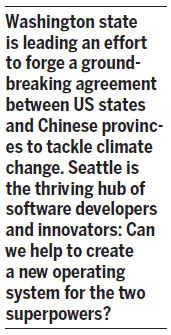

When President Xi Jinping visits the United States this week to meet with President Obama in Washington, a key question they will face is what kind of model can best guide the relationship between these two powerful countries. Can the dominant world power and an emerging new superpower find room to co-exist without the need for conflict or war?
Both countries would be well served in looking to the other Washington for clues.
The relationship between Washington state and China began in the late 1970s, just as China opened up, with farsighted leaders and the practical realities of selling airplanes to a country emerging form isolation.
US Senator Warren Magnuson, one of the earliest advocates of normalizing relations with China, saw the value of connections between people as far more important than ideology. He welcomed Chinese leader Deng Xiaoping to Seattle in 1979 and, later that year, the first PRC ship to the United States.
Almost 40 years later, this mutually beneficial partnership has grown to encompass scientific research, international education, agriculture and sustainable development.
Washington state and China have a robust trade partnership now worth $29 billion a year that has withstood both changing political environments and seismic economic shifts.

But while trade has been the bedrock, this relationship is also emerging into a new paradigm. Washington state and China are increasingly bound together by the exchange of human capital, education, information, culture, tourism and shared interests to protect the environment and improve health.
American and Chinese partners are now working together to solve problems that impact the world. This is part of a necessary evolution of US-China relations: from making friends to making money to making a difference.
Consider that a decade-long partnership between Seattle health nonprofit PATH and China National Biotec Group (CNBG) led to a new, more affordable vaccine for Japanese encephalitis that can reach more than 100 million children in poor countries.
The University of Washington and Beijing's Tsinghua University, backed by Microsoft, are partnering to open a new technology graduate school near Seattle. The Global Innovation Exchange is the first Chinese research institution to establish a US location, with students and faculty from both universities and the goal of creating cutting-edge solutions to complex global problems.
This year, Seattle and Shenzhen, two of the most innovative cities in the world, signed a partnership to work together on low-carbon urban development.
Washington state is leading an effort to forge a groundbreaking agreement between US states and Chinese provinces to tackle climate change.
Seattle is the thriving hub of software developers and innovators: Can we help to create a new operating system for the two superpowers?
Last year at a conference in Seattle, the eclectic technologist Nathan Myhrvold pondered the impact of a rising China and declared what an incredible opportunity it is for the world to have another great set of minds to work on global problems.
Washington state's culture and identity have been shaped by inventors, entrepreneurs, rugged individualists, mountain climbers and seafarers. These include Boeing's first engineer, Wong Tsu, a Beijing native who graduated from MIT and designed the company's first plane, the Boeing Model C.
The next generation of engineers or entrepreneurs may draw talent from among the thousands of students from China now studying at universities in Washington. The experience of living here makes a lasting impact, and there is no better source of inspiration than the clear blue skies, pristine forests and snow-capped mountains that surround the Emerald City.
Yet this summer the devastating impacts of a massive drought and above-normal temperatures produced the largest forest fires in state history, and rising temperatures in lakes and rivers have greatly diminished local salmon runs.
As the two largest economies and emitters of greenhouse gases, the United States and China have a special responsibility to lead the world in reducing the threat of climate change. Many people in Washington state are watching to see whether these leaders will rise to the challenge.
The challenges that have directly impacted Washington state are not insignificant, including cybersecurity violations and intellectual property theft, suspensions of Washington state apple and seafood exports (now lifted) and other trade issues.
Confronting these difficult problems will require a commitment to finding a long-term solution that is mutually beneficial and relying on the trust established and the knowledge that our futures are inexorably linked.
Indeed, while President Xi Jinping and President Barack Obama are at the helm, we are fortunate today that the relationship is not solely in their hands. It is built daily by countless entrepreneurs, scientists, teachers and environmentalists working with their Chinese peers and forging links across the Pacific that keep the ties stable in turbulent seas.
People like Jim Whittaker, the Seattle mountaineer who was the first American to summit Mount Qomolongma, are taking action. Whittaker assembled climbers from the US, China and Russia to jointly scale Mount Qomolongma 25 years ago in support of peace and conservation.
Monday, on the eve of Xi's stop in Seattle, Whittaker was organizing the Peace Climb Anniversary along with Chinese mountaineers such as Wang Shi, who founded real estate giant Vanke, and Wang Jian, the scientist behind BGI, one of the world's top genetic sequencing companies.
Their shared goal, says Whittaker, is to "turn the spotlight on what people all over the world truly want: peace, and a safe, clean planet for their children".
The author is executive director of the Washington State China Relations Council.